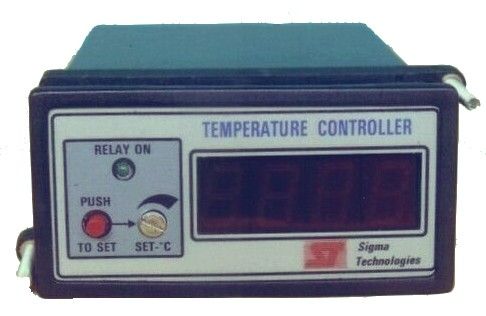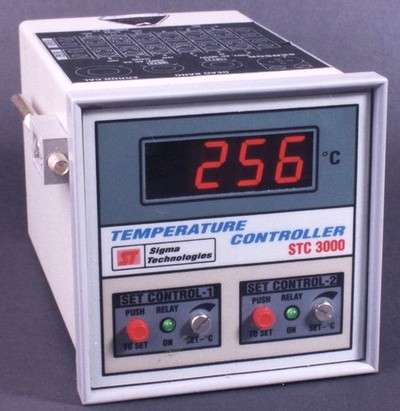Temperature Measurement and Control
PDF Schematics
- Display ICL7107 - Temperature controller
- Regulated Power Supply of Controller
- Proportional Control
Module - TC
- Dual or Two Set Point Module - TC
- Pt-100 RTD and V-I
Proportional Module
- 4-20 mA Proportional
Control Module
- RTD ON-OFF Control Module for TC
A 1/8 DIN Indicating Temperature Controller, 48-96. This is a Analog Controller built around ICL7107.
This is a 48-96 DIN Temperature Controller, it is mains operated, it is in a Industrial Plastic Housing. It is not meant for very harsh environments. Suitable for Control Panels in Control Rooms. It has a accuracy and linearity of 0.5%. It had options of on-off or time proportional control.

Two Setpoint Temperature Controller
A Two Point Process Controller or Temperature Controller would look like this. When a High-Low Alarm Protection for uC based Controller was needed the same was modified and used.
Sometimes uC based instruments just forget and that can be costly, the watchdog timer has solved this problem. In Industrial Process Control we cannot take any chances, so a two tier or even three tier protection is required, especially so if the Job or Raw material being processed is expensive. So Real Time Analog Trip with uC Controller is safe. Then you can still have Electro Mechanical Devices for Extra protection against Fire or Meltdown.

Temperature is the most common process parameter, Pressure seems to be next. Flow, Humidity, Strain, Torque, Level, RPM, Distance and many more follow.
When a physical parameter let us say distance is measured, we first need a sensor that converts it into electrical values, digital, pulses(events/limit) or analog. The sensor used for length is a Linear encoder and it creates the electrical information for the DRO to Display.
Now many sensors like a strain gauge produce very low and weak signals and some are non-linear. So the signals undergo Amplifying, Temperature compensation, EMI/RFI or Noise Cancellation and Linearizing together called Signal Conditioning. This stage outputs some standard values like 4-20mA, 0-10 V, 1-5V, or even directly digital or wireless in the new technologies of today. Even when a digital interfacing standard is used, amplification and some signal conditioning is required at sensor end. Compensation, Linearizing and Noise Rejection can be better done with a uC using Math, Look up Tables, DSP, Software Filters etc..
When you have many different parameters, then it is better to
use process controllers with a 4-20mA input standard. Then the
inventory of controllers can be limited, as it can be reused
for any other process.
It is always better to use sensor-end transmitters to get 4-20mA to your Controller, Recorder, Data Logger or SCADA System.Weak signals are corrupted by noise and dont travel a long wire distance. Junction EMF at joints and terminals blocks add to errors. These are overcome by the 4-20mA signal that has the juice and punch to transmit the data over the shop floor to the control panel rooms. Some times Optical or Magnetic isolation and modulation of analog signals is required. When the signal wires have to mesh with high power lines on their way back (not a good practice) or the sensors could get accidental exposed to live energy points; the control room or panel instruments can be damaged.
Lastly where corrosive materials are being processed, assume
it is always so; Protection is needed for sensors, junctions
and wires. When volatile fluids are being processed, the
sensors, wires, control units all must perform at low energy
levels; sealed hermetically, etc. A tiny battery spark may
undo all the measurement and control efforts !
Complete designs and PCB of a Generic Analog Controller
Main Cards having Power Supply and Digital Display
- Temperature Controller Main Card
- Display ICL7107 - Temperature controller
- Two
Set Point - Display Card - Process Controller
Signal Conditioning and Control Modules on
BergStick/soldering.
- RTD Pt-100 Signal Conditioning Module
- Proportional Module for Process Controller
- Thermocouple and Current Input Module
...
...
...
...
...
delabs Technologies
20th Mar 2020
...
The documents, software, tools and links are provided to enhance the ability of an electronics student, hobbyist or professional by sharing information. The information, links etc. should be used by the website visitor, at his or her own risk and responsibility. There may be concept, design and link errors in the pages.
Creative Work, ideas and documents of delabs can be used for Product Design and Development by R&D Engineers, Hobbyists, Students and even firms for creating useful products. These cannot be used for reprint, replication or publishing online or offline.

